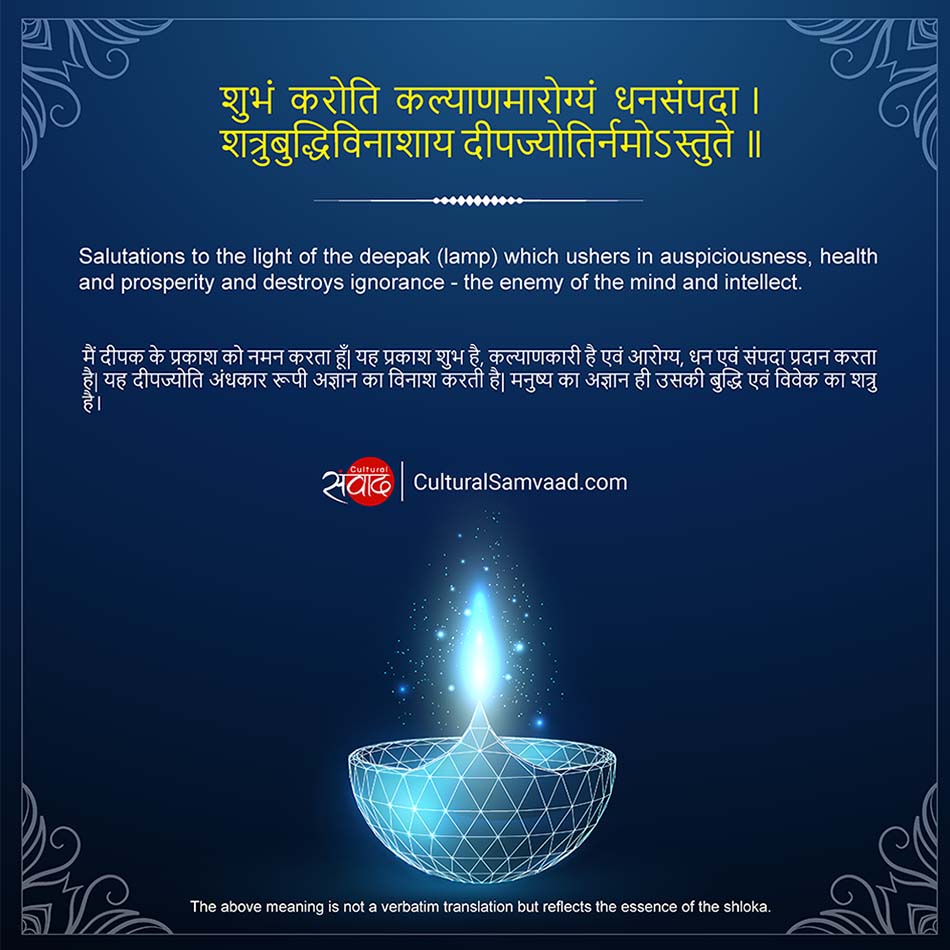Join Cultural Samvaad’s WhatsApp Channel
As innumerable rows of diyas light up every nook and corner of India on Deepawali, they turn a no-moon night (Diwali is a five days long festival but the festivities reach a crescendo on the amavasya of Kartika) into a night brighter and more beautiful than a full-moon night. The diya…the deepak…the humble lamp on the day of Diwali and on every other day is omnipresent in India. It is an enduring, endearing and exhilarating symbol for Indians. It is a symbol of celebration and it is a symbol of much more…
Do You Know: Why is Diwali celebrated? Watch and read the many stories of Diwali.
Why do we light the diya or deepak, the radiant lamp?
Most living beings yearn for light. The lighting of the diya physically satisfies that yearning. The diya in its outward form is a celebration of life. The light of the diya provides joy and overcomes darkness. It is a spectacle that the eyes feast on.
What is the symbolism of flame of the lamp (deep jyoti)?
The flame of the diya (deep jyoti) signifies both the divine who is self-effulgent (the paramatma) and illuminates the entire universe and the soul (the atma) which illuminates us from within. The atma is the immortal light within each living being that is not mortal and is one with the paramatma.

What does the light of the diya gently whisper?
Light is metaphorically a symbol for victory in Indian culture. It reminds us of the victory of truth over falsehood, of light over darkness, of knowledge over ignorance, of dharma over adharma and of hope over despair.

Light is truth. Light is knowledge. Light is hope. Light is dharma. Light is infinite.
Truth is like light. Truth shines through a web of deceit and darkness and stands there with its head held high like the flame that burns upward.
Knowledge is light. True knowledge and right knowledge light up existence. Like light, knowledge is endless.
Hope is light. When there is darkness all around, that little ray of hope makes its way through the smallest crack and illuminates the darkest of spaces at the pace of light.
Dharma is light. It vanquishes adharma. On Diwali, the divine descends in the form of light to re-assure mortals that adharma (non-righteous conduct) will be and shall be overcome by dharma (righteous conduct).
Light is infinite and boundaryless. The sparling rows of deepaks have another message. Light (prakash) cannot be contained or confined. The diya does not illuminate only she, who lights it, but everything and everyone around. The light from each individual diya does not jostle for space, the light from all diyas merge together seamlessly and bright becomes brighter and brighter becomes brightest.
Deepawali reminds us that the light within us is not only meant to illuminate our lives but also the entire earth. And the earth has diversity – diversity of human beings and diversity of living beings. They are all meant to live together, there is no real jostling of space and the unity in that diversity is true light, real light. – Vasudhaiva Kutumbakam – वसुधैव कुटुम्बकम्|
जलाओ दीये पर रहे ध्यान इतना
अँधेरा धरा पर कहीं रह न जाए।
-Padmashri Niraj
When you light diyas, be mindful of the fact no corner of the earth should be enveloped in darkness.
What is the historical significance of the clay lamp or diya?
The diya in its material and metaphorical forms has thrived in our land for many millennia. It is an integral part of Indian culture and heritage. As one stands and stares at a diya one cannot but wonder… am I beholding a piece of antiquity that is lighting up my Diwali? Is it the same diya – moulded skillfully by the potter with the clay of this land that our ancestors used to light up their lives with?
The humble, handcrafted clay lamp is the real deal…the real diya – it has survived millennia and will hopefully survive for many more…no electrical lights can light up our Diwali in the way these handcrafted diyas from our potters do. The clay diya is eco-friendly and merges with mother earth leaving no trace, except the warmth of its light behind. That is the eternal message of the diya.
May the light of innumerable diyas illuminate your lives.
शुभं करोति कल्याणमारोग्यं धनसंपदा ।
शत्रुबुद्धिविनाशाय दीपज्योतिर्नमोऽस्तुते ॥
śubham karōti kalyāṇam
ārōgyam dhana saṁpadaḥ
śatrubuddhi vināśāya
dīpa jyōtir namōstutē!
Salutations to light of the deepak which brings auspiciousness, health and prosperity and destroys ignorance – the enemy of the intellect.

शुभ दीपावली!
Author’s Notes:
- The following words have been used interchangeably in the note above.
- Diya (दीया), Deepak (दीपक) and lamp.
- Diwali and Deepawali
- We prefer atma ( आत्मा ) to soul when speaking of Indian tradition.
- We prefer paramatma (परमात्मा) to God in this context.
- If one peruses the artefacts of the Indo- Saraswati civilization which are today dated to at least 4,500+ years ago, one realises that one of the most striking exhibits of the Indus Valley civilisation is also the humble diya.


Beautifully written.
Thanks Neelkanth Mehtaji!